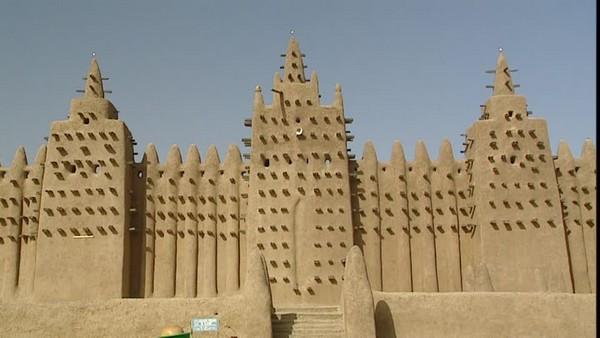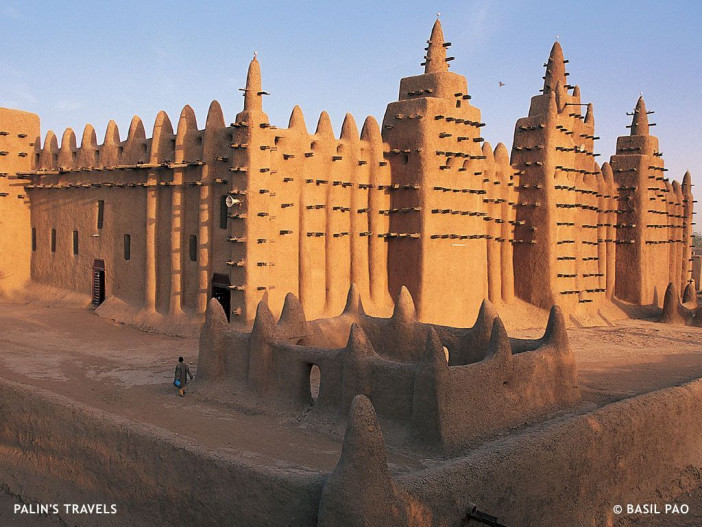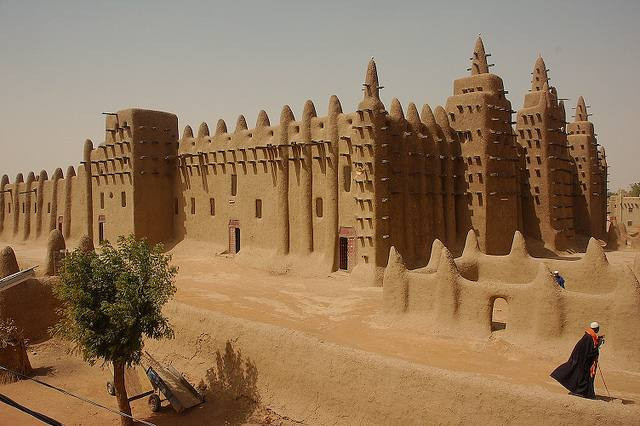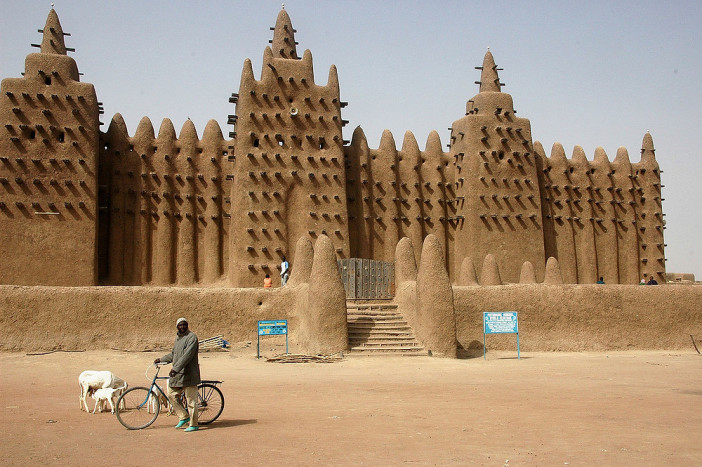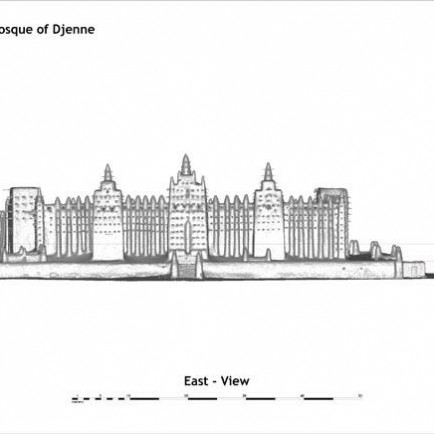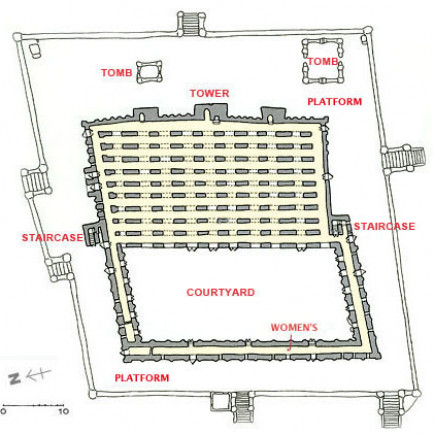The Great Mosque of Djenne
History
The Great Mosque of Djenné differs from other mosques in West Africa in that it was built in a place free of any other previous religious building: this place was previously occupied by a palace. King Koi Kunboro (or Komboro), freshly converted to Islam, had his residence demolished and in 1238 had the great mosque built on its site.
The other mosques were usually built in place of conical pyramidal buildings, made of adobe or stone, supposed to represent the protective spirits of the ancestors. Islamic architecture experts such as Labelle Prussin believe that these conical constructions were integrated into the design of mosques throughout Mali, and consider the Great Mosque of Djenné to be the most telling example.
Djenne later became one of the main cities of the empires of Mali and Songhai.
Urban and Architectural
The mosque has the shape of a square of 75 meters on each side and pyramidal. Its height is 20 meters. The roof is supported by 90 pillars and has 104 ventilation holes. It can hold a thousand people.
The prayer wall or quibla faces east in the direction of Mecca; it overlooks the market place of Djenné. This wall is dominated by three large rectangular-shaped minarets that protrude, as do the eighteen buttresses. Each of the minarets contains a spiral staircase leading to the summit platform. The top of each tower ends in a cone topped with an ostrich egg.
The walls are 40 to 20 cm thick; this depends on their height, the tallest are the thickest, their base must indeed be proportional to their weight. They are made of raw earth bricks, called ferey, jointed with mortar and coated with a layer of plaster, both of the same composition. This plaster gives the building its gently rounded shapes. Bundles of palm branches are driven into the depth of the walls to absorb the cracks that come from the varying stresses of temperature and humidity changes. They give the building a really characteristic spiky look. The mud walls insulate the interior of the building from the strongest heat during the day, ensuring thermal regulation with the cooler nights. Earthen pipe gutters overflow the edge of the roof and channel rainwater away from the walls.
Description
Half of the mosque is covered with a roof, the other half is an open-air prayer courtyard. The roof is supported by 90 wooden pillars, spread over the entire surface. Vent holes in the roof are covered with removable ceramic domes to keep rain out, and which can be removed to allow ventilation when the air inside is too hot. A second prayer room is set up in a closed enclosure behind the covered part: it is delimited by exterior walls to the north, south and west, and to the east by the covered part and surrounded by arcades. The walls of the arcade between the covered room and the courtyard are pierced with vaulted openings 15 m high: they allow the view or the circulation of people.
References
https://www.globe-trotting.com/post/grande-mosquee-djenne-mali
https://www.bbc.com/afrique/monde-58369412
https://www.beauxarts.com/vu/la-grande-mosquee-de-djenne-un-tresor-a-proteger/
Details
Location
Djenne, Mali
Worshippers
2500
Owners
King Koi Kunboro
Year of Build
1906
Area
5500
Drawings
Map
History
The Great Mosque of Djenné differs from other mosques in West Africa in that it was built in a place free of any other previous religious building: this place was previously occupied by a palace. King Koi Kunboro (or Komboro), freshly converted to Islam, had his residence demolished and in 1238 had the great mosque built on its site.
The other mosques were usually built in place of conical pyramidal buildings, made of adobe or stone, supposed to represent the protective spirits of the ancestors. Islamic architecture experts such as Labelle Prussin believe that these conical constructions were integrated into the design of mosques throughout Mali, and consider the Great Mosque of Djenné to be the most telling example.
Djenne later became one of the main cities of the empires of Mali and Songhai.
Urban and Architectural
The mosque has the shape of a square of 75 meters on each side and pyramidal. Its height is 20 meters. The roof is supported by 90 pillars and has 104 ventilation holes. It can hold a thousand people.
The prayer wall or quibla faces east in the direction of Mecca; it overlooks the market place of Djenné. This wall is dominated by three large rectangular-shaped minarets that protrude, as do the eighteen buttresses. Each of the minarets contains a spiral staircase leading to the summit platform. The top of each tower ends in a cone topped with an ostrich egg.
The walls are 40 to 20 cm thick; this depends on their height, the tallest are the thickest, their base must indeed be proportional to their weight. They are made of raw earth bricks, called ferey, jointed with mortar and coated with a layer of plaster, both of the same composition. This plaster gives the building its gently rounded shapes. Bundles of palm branches are driven into the depth of the walls to absorb the cracks that come from the varying stresses of temperature and humidity changes. They give the building a really characteristic spiky look. The mud walls insulate the interior of the building from the strongest heat during the day, ensuring thermal regulation with the cooler nights. Earthen pipe gutters overflow the edge of the roof and channel rainwater away from the walls.
Description
Half of the mosque is covered with a roof, the other half is an open-air prayer courtyard. The roof is supported by 90 wooden pillars, spread over the entire surface. Vent holes in the roof are covered with removable ceramic domes to keep rain out, and which can be removed to allow ventilation when the air inside is too hot. A second prayer room is set up in a closed enclosure behind the covered part: it is delimited by exterior walls to the north, south and west, and to the east by the covered part and surrounded by arcades. The walls of the arcade between the covered room and the courtyard are pierced with vaulted openings 15 m high: they allow the view or the circulation of people.


